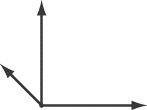2. E
Particle C exerts an attractive
force on the negatively charged particle B.
If B is to be pulled in the
direction of A,
A must exert an even stronger
attractive force than particle C.
That means that particle A must have
a stronger positive charge than particle C,
which is +q.
3. E
The electric force exerted by one charged particle on another is proportional to
the charge on both particles. That is, the force exerted by the +2q particle on the –q particle is of the same magnitude as
the force exerted by the –q particle
on the +2q particle, because,
according to Coulomb’s Law, both forces have a magnitude of:

Since one particle is positive and the other is negative, this force is
attractive: each particle is pulled toward the other. Since the two particles
are pulled toward each other, the forces must be acting in opposite directions.
If one particle experiences a force of F,
then the other particle must experience a force of –F.
4. B
Coulomb’s Law tells us that
F = kq1q2/r2S:
the force between two particles is directly proportional to their charges and
inversely proportional to the square of the distance between them. If the charge
of one of the particles is doubled, then the force is doubled. If the distance
between them is doubled, then the force is divided by four. Since the force is
multiplied by two and divided by four, the net effect is that the force is
halved.
5. C
Particles C and
D exert a repulsive force on
A, while
B exerts an attractive force. The
force exerted by D is somewhat less
than the other two, because it is farther away. The resulting forces are
diagrammed below:

The vector sum of the three vectors will point diagonally up and to the right,
as does the vector in C.
6. E
The vector for electric field strength at any point has a magnitude of
E = kQ/r2
and points in the direction that a positive point charge would move if it were
at that location. Because there are two different point charges,
Q1
and
Q2,
there are two different electric fields acting at point
A. The net electric field at
A will be the vector sum of those
two fields. We can calculate the magnitude of the electric field of each charge
respectively:

Since both
Q1
and
Q2
would exert a repulsive force on a positive point charge,
EQ1
points to the right and
EQ2
points to the left. The net electric field is:

Because
Q1
is closer to A than
Q2,
the electric field from
Q1
will be stronger than the electric field from
Q2,
and so the net electric field will point to the right.
7. D
The charged surface is a plane charge, and the electric field exerted by a plane
charge is E = kq. That is, the
magnitude of the electric field strength does not vary with distance, so a
particle of charge +q will
experience the same attractive force toward the charged surface no matter how
far away it is.
8. B
The change in potential energy of a point particle, with reference to infinity
is given by:

The difference in potential energy between two points is given by:

9. B
The electric potential of a charge is given by the equation
V = kq/r. In other words, distance
is inversely proportional to electric potential. If the distance is doubled,
then the electric potential must be halved.
10. D
Excess charges always reside on the surface of a conductor because they are free
to move, and feel a repulsive force from each other.
Next to display next topic in the chapter.
Practice Questions
Video Lessons and 10 Fully Explained Grand Tests
Large number of solved practice MCQ with explanations. Video Lessons and 10 Fully explained Grand/Full Tests.